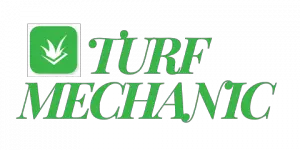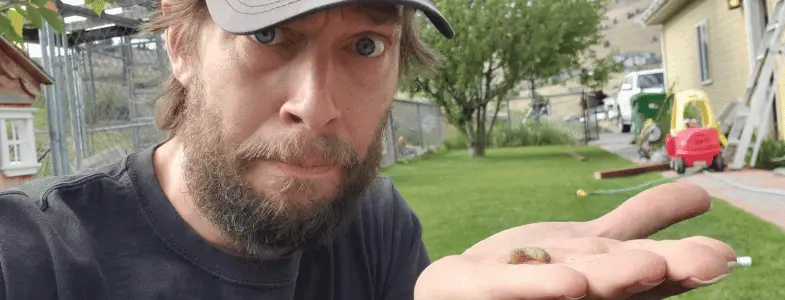Grubs—without a doubt, are one of the biggest fears homeowners have when it comes to their lawn and it’s all because they live underground and eat the roots of our grass killing it off in patches or even worse, in large expansive areas.
These pests are the larvae of different scarab beetles like Japanese beetles and June bugs among others.
The distiction between grub preventing and killing however has to do with the youthfullness of the grub itself.
It actually starts it’s lifecycle as a true larvae in the early summer, end of June through the early weeks of August.
Grub control products or preventers only kill grub larvae in this earliest stage; they don’t do anything to “adult” grubs that we see in late August through April.
If you think you have grub problems between Sept and April then you have to use a more agressive grub killer product to rid your lawn of these pests before that pupate and turn into beetles that are found en masse during the later parts of Spring (May & June).
The Different Types Of Grub Control Products
If you’re still reading this page, then chances are high that you have grubs in your lawn and are investigating products to get rid of them.
There are two different products available—grub preventers and grub killers—and it’s critical to understand the difference between them because they work differently.
- Grub preventers contain an ingredient that targets the eggs and young larvae, so they work to control grubs in their early life stages.
- Grub killers target active mature grubs in your lawn, killing on contact.
- It is not typical to apply insect killers to a lawn to kill beetles after they pupate but before they burrow to lay their eggs.
1. Grub Preventers
Grub preventers offer the best protection, but application timing is critical.
These products only work on eggs and young larvae, so applying them right before or when the eggs hatch is necessary. If applied too early, the active compounds may break down or move down through the soil before larvae hatch, making them ineffective.
Apply grub preventers containing imidacloprid, thiamethoxam, BT, or clothianidin in late spring or early summer. In most areas, this is June or July. These products enter the soil quickly so applying them slightly ahead of larvae emerging from eggs is crucial.
In the case of BT, a natural grub control option split applications is best as the active ingredient is only substantially active in the soil for about 10 days. I recommend applying split applications of BT around June 20, July 1, and July 15 to achieve solid coverage during the peak season.
Chlorantraniliprole-based products take much longer to move into the soil because they are not water soluble. Other than BT these products are typically considered to be much more friendly to the environment and the desirable bugs and bees around your lawn. These preventors should be applied to the lawn in late April through the first bit of June to have best efficacy rates. Best practice is to aim for early May to ensure enough of the active ingredient gets into the egg zone by July.
2. Grub Killers
Grub killers can be applied at any time of the year you see grub activity however they are best applied early in the Fall or early in the Spring to get the best bang for your buck.
When applied in Sept these products will easily be able to target all grubs well before they burrow down to “hibernate” for the winter.
When applied in March these products will have the most amount of time to target the grubs after they wake up from winter but prior to them pupating and turning into beetles.
Most of these products use carbaryl, bifenthrin, or trichlorfon as their active ingredients to kill grubs in all of their adult life stages. They aren’t as effective however at reducing grub populations as preventers, and they are well known to be less selective meaning their chemical footprint harms many other non-target species.
Although they do tend to kill grubs very effectively, I don’t usually recommend their use unless a substantial problem already exists in a lawn.
Life Cycle of Grubs
Due to their differences, the products must be applied at precise times of the grubs’ life cycle to work effectively. Regardless of the type of grub you’re dealing with in your yard, they go through four distinct life cycle phases: egg, larvae, pupa, and adult.
- Eggs are typically laid June through August.
- After hatching, larvae feed on the turf’s roots close to the surface, continuing until late fall. This is when you may start to see damage to your lawn. At this time, they are the most vulnerable to chemical control.
- As temperatures drop, the larvae move down through the soil to be below the frost line, where they can overwinter safely. They cannot be controlled at this time because they are too far beneath the soil surface.
- In early spring, the larvae move back to the surface and feed voraciously in preparation for pupation. This is when the damage is most evident, but the larger larvae are less vulnerable to chemical control because their outer skins are thickening. After feeding for a while, the larvae begin pupating.
- Adult beetles emerge from the soil through the surface. The adults then mate and lay eggs.
If you need to deal with grubs in the lawn then make sure to see my product recommendations linked below:
These are my recommendations which apply to most people (obviously there are some exceptions however).
Use Scott’s Grub Ex which uses Chlorantraniliprole in May to prevent grubs in the lawn or BT (Lawnbox’s Grubout) or (Phyllom BioProducts’ GrubGone) around the 1st of July.
If it’s already June and you have a very bad infestation of grubs then it is likely too late to apply GrubEx to the lawn and BT will probably not be effective enough to get good control in a single season. This is the only time I recommend using Imidacloprid. It has the highest efficacy rate of all common grub preventers used in the lawn and works well when applied in June. It is however very destructive to many unintended targets like birds, bees, and butterflies just to name a few.
I own Ike’s Lawn Grub control which uses Imidacloprid but I’ve never actually used it on my own lawn because I don’t like the side effects of the ingredient. I believe this product was recently discontinued however so an alternative is this basic Imidacloprid sold in gallon and 1/5 gallon sizes.
If you absolutely need to kill adult grubs in March, April, or at any time during Autumn, then apply BioAdvanced 24-Hour Grub Killer Plus which uses Trichlorfon. Again, it’s going to kill many other soil life that we don’t want to kill so I would not rely on this stuff on a year to year basis.
One other popular natural option is to apply milky spore to the lawn to prevent grubs. This is a great option for people that have almost no problem at all or for those people that are also using one of the aforementioned products above because it takes multiple season for milky spore to accumulate in the lawn to the point where it becomes a proper preventative. Essentially applying milky spore for three consecutive years will start preventing grubs in year four so it is the long play but super worth it if you care about the health of your soil.
Below I’ve embedded a few videos I’ve produced on lawn grub control. Feel free to watch any of them for more context.
When To Apply Grub Control, What To Use & Why
When Is It Too Late To Prevent Grubs?
What Is The Organic and/or Natural Way To Prevent Grubs?
Many People That Try To Kill Grubs In The Fall Make This Mistake
Scott’s GrubEX Is A Great Product But Many People Use It Incorrectly

